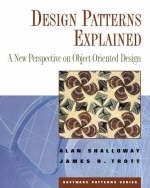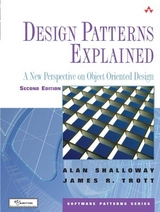
Design Patterns Explained
Addison Wesley (Verlag)
978-0-201-71594-1 (ISBN)
- Titel erscheint in neuer Auflage
- Artikel merken
Design Patterns Explained: A New Perspective on Object-Oriented Design draws together the principles of object-oriented programming with the power of design patterns to create an environment for robust and reliable software development. Packed with practical and applicable examples, this book teaches the student to solve common programming problems with patterns--and explains the advantages of patterns for modern software design.
Beginning with a complete overview of the fundamentals of patterns, Design Patterns Explained stresses the importance of analysis and design. The authors clearly demonstrate how patterns can facilitate the overall development process. Throughout the book, key object-oriented design principles are explained, along with the concepts and benefits behind specific patterns. With illustrative examples in C++ and Java, the book demystifies the "whys," "why nots," and "hows" of patterns and explains pattern implementation.
Alan Shalloway is the founder, CEO, and principal consultant of Net Objectives, an object-oriented consulting/training organization. He has a master's degree in computer science from MIT, over thirty years of experience in software development, and several years of experience in mentoring and training. He spends much of his time offering courses in design patterns, OOA, OOD, and lightweight methodologies, and building advanced software for both his own company and his clients. James R. Trott is a senior consultant for a large software company in the Pacific Northwest and formerly was a senior engineer for a large aerospace company. He holds a master of science in applied mathematics, an MBA, and a master of arts in intercultural studies. He has spent seventeen years in the field of artificial intelligence, knowledge modeling, and knowledge management and is an expert in using cognitive design patterns and the KADS methodology. 0201715945AB06142001
Preface.
From Object Orientation to Patterns to True Object Orientation.
From Artificial Intellegence to Patterns to True Object Orientation.
I. AN INTRODUCTION TO OBJECT-ORIENTED SOFTWARE DEVELOPMENT.
1. The Object-Oriented Paradigm.
Before The Object-Oriented Paradigm: Functional Decomposition.
The Problem of Requirements.
Dealing With Changes: With Functional Decomposition.
Dealing with Changing RequirementS.
The Object-Oriented Paradigm.
Special Object Methods.
Summary.
2. The UML - The Unified Modeling Language.
Overview.
What is the UML?
Why Use the UML?
The Class Diagram.
Interaction Diagrams.
Summary.
II. THE LIMITATIONS OF TRADITIONAL OBJECT-ORIENTED DESIGN.
3. A Problem that Cries Out for Flexible Code.
Overview.
Extracting Information from a CAD/CAM System.
Understand the Vocabulary.
Describe the Problem.
The Essential Challenges and Approaches.
Summary.
4. A Standard Object-Oriented Solution.
Overview.
Solving With Special Cases.
Summary.
Supplement: C++ Code Examples.
III. DESIGN PATTERNS.
5. An Introduction to Design Patterns.
Overview.
Design Patterns Arose from Architecture and Anthropology.
Moving from Architectural to Software Design Patterns.
Why Study Design Patterns.
Other Advantages to Studying Design Patterns.
Summary.
6. The Facade Pattern.
Overview.
Introducing the Facade Pattern.
Learning the Facade Pattern.
Field Notes: The Facade Pattern.
Relating the Facade Pattern to the CAD/CAM Problem.
Summary.
7. The Adapter Pattern.
Overview.
Introducing the Adapter Pattern.
Learning the Adapter Pattern.
Field Notes: The Adapter Pattern.
Relating the Adapter Pattern to the CAD/CAM Problem.
Summary.
Supplement: C++ Code Examples
8. Expanding Our Horizons.
Overview.
Objects the Old Way and the New Way.
Encapsulation the Old Way and the New Way.
Find What is Varying and Encapsulate It.
Commonality / Variability and Abstract Classes.
Summary.
9. The Bridge Pattern.
Overview.
Introducing the Bridge Pattern.
An Observation about Using Design Patterns.
Learning the Bridge Pattern: An Example.
The Bridge Pattern In Retrospect.
Field Notes: Using the Bridge Pattern.
Summary.
10. The Abstract Factory Pattern.
Overview.
Introducing the Abstract Factory Pattern.
Learning the Abstract Factory Pattern: An Example.
Learning the Abstract Factory: Implementing It.
Field Notes: The Abstract Factory.
Relating the Abstract Factory Pattern to the CAD/CAM Problem.
Summary.
Supplement: C++ Code Examples.
IV. PUTTING IT ALL TOGETHER: THINKING IN PATTERNS.
11. How Do Experts Design?
Section Overview.
Overview.
Building by Adding Distinctions.
Summary.
12. Solving the CAD/CAM Problem with Patterns.
Overview.
Review of the CAD/CAM Problem.
Thinking in Patterns.
Thinking in Patterns: Step 1.
Thinking in Patterns: Step 2A.
Thinking in Patterns: Step 2B.
Thinking in Patterns: Step 2D (Facade).
Thinking in Patterns: Step 2D (Adapter).
Thinking in Patterns: Step 2D (Abstract Factory).
Thinking in Patterns: Step 3.
Comparison with the Previous Solution.
Summary.
13. The Principles and Strategies of Design Patterns.
Overview.
The Open-Closed Principle.
The Principle of Designing from Context.
The Principle of Containing Variation.
Summary.
V. HANDLING VARIATIONS WITH DESIGN PATTERNS.
14. The Strategy Pattern.
Overview.
An Approach to Handling New Requirements.
Initial Requirements of the Case Study.
Handling New Requirements.
The Strategy Pattern.
Field Notes: Using the Strategy Pattern.
Summary.
15. The Decorator Pattern.
Overview.
A Little More Detail.
The Decorator Pattern.
Applying the Decorator Pattern to the Case Study.
Another Example: Input / Output.
Field Notes: Using the Decorator Pattern.
Summary.
Supplement: C++ Code Examples.
16. The Singleton Pattern and the Double-Checked Locking Pattern.
Overview .
Introducing the Singleton Pattern.
Applying the Singleton Pattern to the Case Study.
A Variant: The Double-Checked Locking Pattern.
Field Notes: Using the Singleton and Double-Checked Locking Patterns.
Summary.
Supplement: C++ Code Examples.
17. The Observer Pattern.
Overview.
Categories of Patterns.
More Requirements for the Case Study.
The Observer Pattern.
Applying the Observer to the Case Study.
Field Notes: Using the Observer Pattern.
Summary.
Supplement : C++ Code Examples.
18. The Template Method Pattern.
Overview.
More Requirements for the Case Study.
The Template Method Pattern.
Applying the Template Method to the Case Study.
Field Notes: Using the Template Method Pattern.
Summary.
19. The Factory Method Pattern.
Overview.
More Requirements for the Case Study.
The Factory Method Pattern.
Field Notes: Using the Factory Method Pattern.
Summary.
20. The Analysis Matrix.
Overview.
In the Real World: Variations.
Case Study in Variation: An International E-Tail System.
Field Notes.
Summary.
VI. ENDINGS AND BEGINNINGS.
21. Design Patterns Reviewed From Our New Perspective of Object-Oriented Design.
Overview.
A Summary of Object-Oriented Principles.
How Design Patterns Encapsulate Implementations.
Commonality / Variability Analysis and Design Patterns.
Decomposing a Problem Domain Into Responsibilities.
Relationships Within a Pattern.
Patterns and Contextual Design.
Field Notes.
Summary.
22. Bibliography.
Design Patterns Explained: The Web Site Companion.
Recommended Reading on Design Patterns and Object Orientation.
Recommended Reading for Java Programmers.
Recommended Reading for C++ Programmers.
Recommended Reading for Cobol Programmers.
Recommended Reading on eXtreme Programming.
Recommended Reading on General Programming.
Personal Favorites.
Index.
| Erscheint lt. Verlag | 18.7.2001 |
|---|---|
| Verlagsort | Boston |
| Sprache | englisch |
| Maße | 186 x 234 mm |
| Gewicht | 586 g |
| Themenwelt | Informatik ► Software Entwicklung ► Objektorientierung |
| Mathematik / Informatik ► Informatik ► Theorie / Studium | |
| ISBN-10 | 0-201-71594-5 / 0201715945 |
| ISBN-13 | 978-0-201-71594-1 / 9780201715941 |
| Zustand | Neuware |
| Haben Sie eine Frage zum Produkt? |
aus dem Bereich



